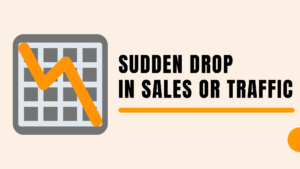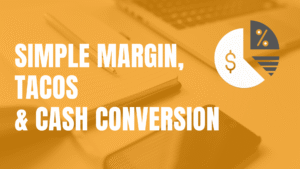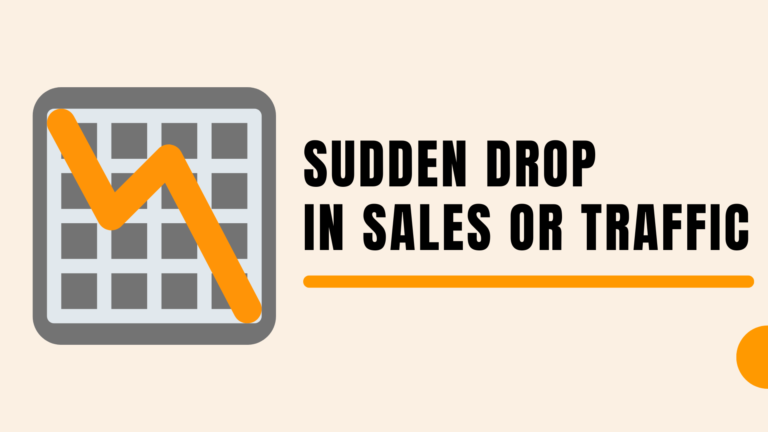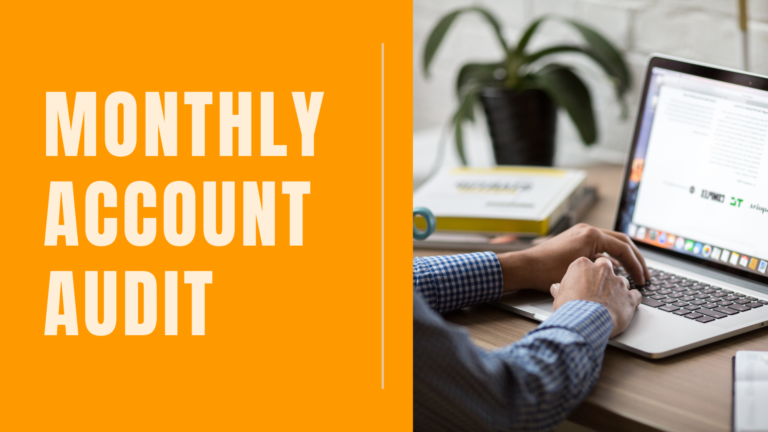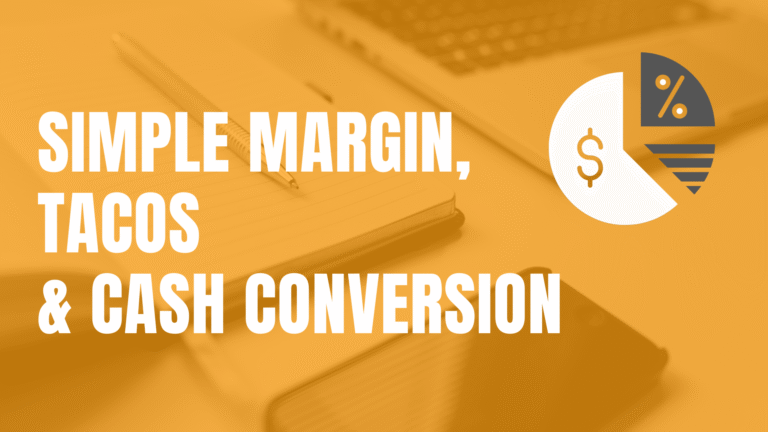There are two primary business models: Amazon Vendor and Seller. Both provide effective methods to reach millions of customers globally via the largest online marketplace. Now is an excellent time to determine which option suits your business best.
What is an Amazon Vendor?
Amazon Vendor refers to a business model where manufacturers or distributors sell their products directly to Amazon.
The Amazon Vendor program is invitation-only. Businesses cannot apply directly. They must be invited by Amazon to join based on factors like brand reputation, sales performance, or product demand.
Upon acceptance, the business operates as a first-party (1P) seller. In contrast to the Seller (3P) model, wherein businesses sell directly to consumers through Amazon Marketplace, vendors in the 1P model sell directly to Amazon.
Vendors in this model manage their relationship with Amazon through a platform called Amazon Vendor Central.
In this arrangement, Amazon takes charge of the inventory and sells those products directly to customers on the Amazon marketplace.
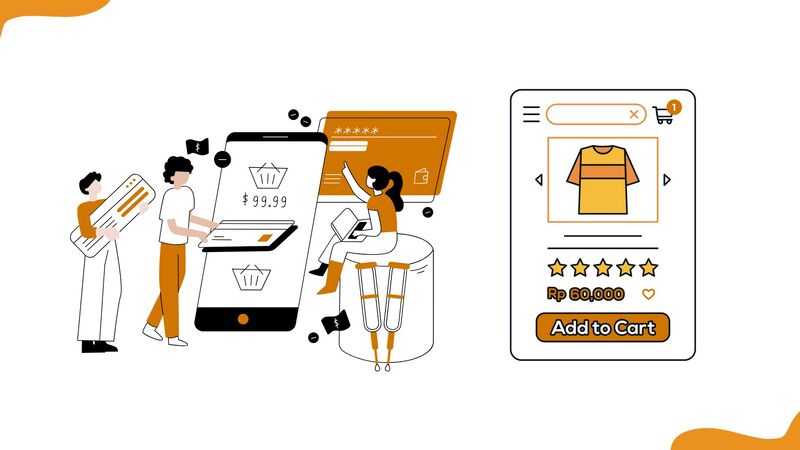
Pros & Cons of Being an Amazon Vendor
With this arrangement, your brand becomes a wholesale supplier to Amazon, which then acts as the retailer. It provides operational convenience and the advantage of being “Sold by Amazon,” along with access to powerful marketing tools. These are benefits most brands wish for.
Pros of Being an Amazon Vendor:
Increased Consumer Trust
When you come across products marked as “Sold by Amazon.com and Shipped by Amazon,” you can truly sense the trust that stems from Amazon’s established reputation.
Simplified Operations
As a supplier, your main duty is to provide products in bulk to Amazon. Amazon then manages the entire retail process, which includes storage, shipping, customer support, and returns.
Potential for High Sales Volume
Amazon often places large bulk orders based on its demand forecasts, giving you a steady and predictable revenue stream.
Premium Marketing Tools
Vendors can get access to exclusive marketing assets like A+ Content and Amazon Marketing Services (AMS).
“Prime” Status
Since your products are sold directly through Amazon, they automatically qualify for Prime, which means fast and free shipping for millions of Prime members. That Prime badge is a major factor in boosting sales on Amazon.
Cons of Being an Amazon Vendor:
Loss of Pricing Control
Once Amazon buys your inventory, it sets the retail price. If it finds a lower price elsewhere, it may automatically adjust the listing price, even if it is below your Minimum Advertised Price (MAP). This can hurt your relationships with other retail partners.
Reduced Profit Margins
The vendor model works on wholesale pricing. You provide Amazon with a lower rate, which leads to a much smaller profit per unit compared to selling directly to consumers as a third-party seller.
Adherence to Standards and Chargebacks
Amazon imposes stringent compliance requirements for labeling, packaging, and delivery. Any discrepancies, like delayed shipments or inaccurate barcodes, may result in chargebacks that diminish your earnings and affect your profitability.
Slow Payment Terms
Vendors are typically paid on Net 60 or longer terms, meaning you might wait months to receive payment after invoicing.
Eligibility
The Amazon Vendor program is exclusive and invitation-based. You cannot apply directly.
What is an Amazon Seller?
An Amazon Seller is an individual or business that sells products directly to customers on the Amazon Marketplace. These sellers are often referred to as third-party (3P) sellers, and they take charge of listing and managing their own products. In fact, 3P sellers now make up about 60% of all paid units sold on Amazon.
Amazon sellers utilize Amazon Seller Central, a digital platform that acts as their main hub for overseeing all elements of their online business, such as product listings, inventory management, order processing, advertising, and customer support.
Amazon sellers can choose between two primary fulfillment methods:
Fulfillment by Amazon (FBA):
Sellers send their inventory to Amazon’s fulfillment centers. Amazon then takes care of the entire logistics process, which includes storage, packing, shipping, customer service, and returns.
FBA enables sellers to delegate their order fulfillment to Amazon, while providing customers with fast, free two-day shipping through Prime. According to Statista, FBA manages the distribution of about half of all items sold in most Amazon markets.
Fulfilled by Merchant (FBM):
Sellers are responsible for managing all logistics on their own or can collaborate with a third-party logistics provider to take care of storage, packing, and shipping. This option is often more suitable for large, specialized, or slow-selling products that may not gain from Amazon’s fulfillment fees or storage arrangements.
Although you can sign up for an Amazon selling account at no cost, there are specific fees associated with selling on the platform.
Amazon provides two primary selling options: the Individual plan ($0.99 for each item sold) and the Professional plan ($39.99 per month, regardless of the number of sales).
In addition to these plan fees, Amazon also charges a referral fee for each item sold, along with possible additional costs if you choose to use optional tools or fulfillment programs like FBA.
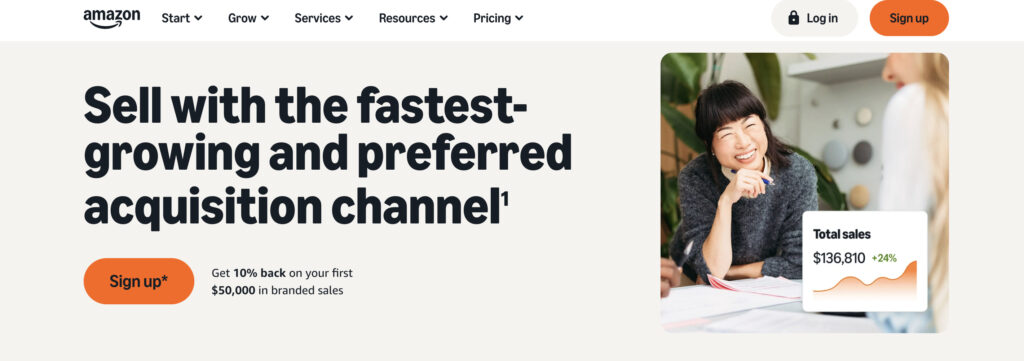
Pros & Cons of Being an Amazon Seller
Becoming an Amazon seller is a business model that offers direct access to one of the largest online marketplaces. It attracts millions of active customers and has effective fulfillment resources.
Pros of Selling on Amazon:
Massive Customer Base and Traffic
You will gain immediate access to an enormous audience of active buyers.
Customer Trust and Credibility
Amazon is known for its dependability, which also applies to its sellers. By offering your products on such a reputable platform, your business immediately acquires trustworthiness and authenticity.
Simplified Logistics
Through Fulfillment by Amazon (FBA), you can offload storage, shipping, customer service, and returns to Amazon.
Prime Eligibility
FBA sellers automatically qualify for Amazon Prime.
Global Market Expansion
With Amazon’s worldwide infrastructure, entering international markets is more straightforward. You can expand into areas such as Europe, Asia, or North America with significantly less setup compared to conventional retail expansion.
Scalability
Amazon provides the tools, systems, and fulfillment capacity that make it simple to scale your business rapidly.
Cons of Selling on Amazon:
High, Complex Fees
Amazon charges several fees that have the biggest impact on your business operations and profitability. Core selling fees:
- Referral fees: A percentage of the total sales price (item price + shipping + gift wrap, excluding taxes). Varies by product category.
- Monthly subscription fee: Charged to Professional sellers for access to bulk listing tools, APIs, reports, and premium placement.
- Per-item selling fee: Paid by Individual sellers for each product sold.
- Closing fees: Applied to media items (e.g., books, DVDs, music) per unit sold.
Intense Competition
You encounter numerous third-party vendors, well-known brands, and even private-label items from Amazon. This results in a challenging landscape characterized by fierce price rivalry and slim profit margins.
Limited Brand Control
Amazon’s product listings follow specific templates. There is little chance to distinguish your brand visually or through packaging, especially when using FBA, since items are shipped in Amazon-branded packaging.
Policy Enforcement & Suspensions
Amazon has a pretty strict enforcement system, and a lot of it is automated. Sellers can find themselves facing unexpected account suspensions or having their listings removed, even for small policy violations. Getting reinstated can be a slow and tough process.
Key Difference between Amazon Vendor vs. Amazon Seller
| Feature | Amazon Vendor (1P) | Amazon Seller (3P) |
| Sales Model | Wholesale / B2B: You sell your products directly to Amazon, and Amazon resells them to customers. | Direct-to-Consumer (D2C): You sell products directly to customers on Amazon’s marketplace. |
| Pricing Control | Limited or no control. Amazon sets the final retail price. | You set your own retail prices and discounts. |
| Fulfillment | Amazon manages all fulfillment, shipping, and customer service. | Fulfillment by Amazon (FBA) OR Fulfilled by Merchant (FBM) |
| Marketing Tools | A+ Content, Amazon Marketing Services (AMS) | A+ Content (with Brand Registry), Sponsored Ads, Amazon Brand Stores |
| Payment Terms | Traditional payment terms such as Net 30, Net 60, or Net 90, depending on the contract | Faster payment cycle, usually every 2 weeks, after the customer purchases |
| SUMMARY: As a Vendor, you sell in bulk to Amazon at wholesale prices, and Amazon will manage pricing, fulfillment, and customer interactions. As a Seller, you maintain full control over your retail pricing, product listings, and customer relationships, selling directly to consumers. Numerous companies begin as sellers on Amazon to enhance their sales, reinforce their brand, and validate market demand for their offerings. After their products attain significant sales and brand awareness, they might get a formal invitation to join Vendor Central or, at the very least, offer some of their products under the Vendor model. In fact, many vendors began as successful sellers. Starting as a Seller is a common and practical way to become an Amazon Vendor. |
How to Choose the Right Model
Seller Central is an excellent choice for startups. It is accessible to anyone and features minimal entry barriers. You have the ability to manage your listings, brand, and product availability.
Vendor Central, on the other hand, is available by invitation only and is typically a good fit for established manufacturers or distributors with products in high demand. Rather than dealing with thousands of customers, you supply Amazon directly through bulk purchase orders (POs).
In practice, it is possible to use both models to strike a balance between scale and flexibility.
Implement the 1P model for your best-selling products that gain from Amazon’s fulfillment capability and reputation. At the same time, utilize the 3P model for trialing new items before selling them wholesale, handling surplus inventory that Amazon does not reorder, or for selling intricate or customizable products that require more personal customer interaction.
Conclusion
It is evident that both have potential benefits based on your business objectives. Research both models, evaluate how big your company is and your strategy, and choose which one will be the best fit for the long-term growth of your business on Amazon.
FAQs
Can I make money from selling on Amazon?
You can make money on Amazon in many ways. Sellers can specialize in a niche, offer refurbished, customizable, or handmade products, or create and sell branded merchandise. You can resell, source wholesale goods, or partner with dropshippers. Beyond selling, you can earn passive income through Amazon’s affiliate marketing program.
Are vendor and seller the same?
Vendor and seller represent two different business relationships with Amazon. Amazon Vendor (1P) is a supplier selling products wholesale directly to Amazon. The product page will say “Ships from and sold by Amazon.” Amazon Seller (3P) IS a retailer selling products directly to the final customer on the Amazon marketplace.
Is Amazon vendor invite-only?
Amazon Vendor Central is an invite-only platform. You cannot sign up or apply to become an Amazon vendor. Amazon will select and invite manufacturers, brands, or authorized distributors. Once invited, you become a first-party (1P) seller, meaning you sell your products wholesale to Amazon, and then Amazon sells them to the end customer.
Can I make $1000 a month selling on Amazon?
You can potentially make a profit of $1,000 or more each month by selling on Amazon. Typically, new sellers can bring in between $500 and $2,000 in revenue each month. More experienced sellers generally achieve monthly revenues ranging from $1,000 to $25,000, with top sellers surpassing $100,000 in sales per month.
What is the monthly fee for being an Amazon seller?
The Professional Selling Plan has a subscription fee of $39.99 each month and offers access to enhanced features such as bulk listing capabilities, the Selling Partner API (SP-API), automated pricing options, in-depth business reports, customizable shipping rates, and eligibility for prime placement on product listings.

